Mastaba of Ti
The mastaba des Ti is the burial site of an official in the ancient Egyptian necropolis of Saqqara .
history
The mastaba was built around 2,400 BC. Built during the 5th Dynasty of the Old Kingdom as a tomb of the Egyptian official Ti. Ti held numerous higher offices, such as administrative or priestly functions in the solar sanctuaries of Sahure , Neferirkare and Raneferef . He had titles such as “The King's Only Friend” or “Supreme Court Hairdresser”. The permission given to him to erect a large mastaba for himself in the necropolis of Saqqara can be understood as a special privilege. Auguste Mariette discovered the mastaba during his excavations in 1865.
Location and structure
The mastaba is located approx. 700 m north of the step pyramid of Djoser . The superstructure of the mastaba was originally free-standing, but is now below the desert sand line. The courtyard (3) of the facility, surrounded by columns, can be reached via a staircase through a vestibule (1). From there a corridor lined with reliefs (4/5) leads to the cult chapel (7), which is also decorated in relief. Behind it, through slits in the wall, the Serdab (8) can be seen, in which there was a larger than life sculpture of Ti, which has now been replaced by a copy (the original is in the Egyptian Museum in Cairo). The sarcophagus (D) is located below the cult chapel in a coffin chamber (C), which can be reached through a low, sloping shaft from the inner courtyard.
Reliefs
The mastaba of Ti is particularly known for its originally colored, fine-line and detailed bas-reliefs , on which Ti and his wife Neferhetpes are depicted in numerous scenes of their daily life, for example working on the land, fishing, hippopotamus hunting, papyrus harvesting, and preparing food of food, or the manufacture of furniture. These representations are considered to be the most artistically outstanding and detailed in Saqqara and form an important source for today's knowledge of everyday life in the Old Kingdom . In a deliberate contrast to these everyday scenes are the reliefs on the west wall of the cult chapel around the false door to the Serdab, which relate solely to cultic acts, such as depictions of sacrificial animals and gift carriers.
Cattle drive through a river
In the scene of cattle drive through a river (north side of the cult chapel), a herd of cattle is driven across a ford through a river. One of the cattle herders carries a calf on his shoulders to get it safely through the water. The young animal anxiously looks back at its mother, who calls for him with her head held high. The scene is characterized by close observation of nature. The “calf bearer” can also be found as a motif in other graves.
Slaughter of the cattle
In the slaughter of the cattle scene (east side of the corridor to the cult chapel), an already slaughtered cattle lies on the floor while a leg is being cut off and containers with the cattle's blood are being taken away. Slaughter scenes are one of the canonical themes in ancient Egyptian tombs. They are supposed to record the offering of meat offerings by priests, which was laid down by written decrees of ancient Egyptian tombs during their lifetime.
literature
- Matthias Seidel, Regine Schulz : Egypt. Art and architecture. Tandem, Potsdam 2005, ISBN 383311424X .
Web links
- Brief description of the Mastaba des Ti on www.chufu.de ( Memento from March 30, 2010 in the Internet Archive ).
- Detailed description of the Mastaba des Ti on www.osirisnet.net (English)
- http://ia600207.us.archive.org/5/items/letombeaudepetos00lefeuoft/letombeaudepetos00lefeuoft.pdf
Individual evidence
- ↑ page Sun Sanctuary of Raneferef . In: Wikipedia, The Free Encyclopedia. Processing status: June 24, 2012.
- ↑ Hans Strelocke: Egypt. History, art and culture in the Nile Valley. DuMont, Cologne 1976, ISBN 3770108361 , p. 227.
- ^ Matthias Seidel, Regine Schulz: Egypt. Art and architecture. P. 212.
- ↑ Hans Strelocke: Egypt. History, art and culture in the Nile Valley. P. 229.
- ^ Matthew Firestone: Egypt. Lonely Planet, London 2010, ISBN 9781741793147 , p. 202.
- ↑ Hans Strelocke: Egypt. History, art and culture in the Nile Valley. P. 230.
- ^ Matthias Seidel, Regine Schulz: Egypt. Art and architecture. P. 215.
- ^ Matthias Seidel, Regine Schulz: Egypt. Art and architecture. P. 213.
Coordinates: 29 ° 52 ′ 38.1 ″ N , 31 ° 12 ′ 42.3 ″ E




